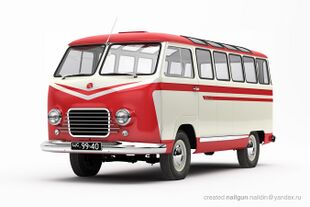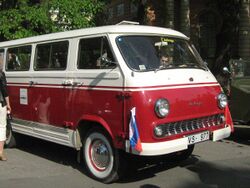Engineering:RAF-977
This article needs additional citations for verification. (July 2022) (Learn how and when to remove this template message) |
| RAF-977 | |
|---|---|
 RAF-977 | |
| Overview | |
| Manufacturer | Riga Autobus Factory |
| Production | 1958-1976 |
| Assembly | RAF Factory, Jelgava, Latvia ErAZ Factory, Yerevan, Armenia |
| Body and chassis | |
| Body style | 4-door, 10-passenger van/minibus/ambulance |
| Related | GAZ-21 Volga ErAZ-762 |
| Powertrain | |
| Engine | 4-cylinder 2,445 cc (149.2 cu in) 75 hp (56 kW; 76 PS) at 4000rpm[1] |
| Transmission | 3-speed manual[1] |
| Dimensions | |
| Wheelbase | 2,700 mm (106 in)[1] |
| Length | 4,900 mm (193 in)[1] |
| Width | 1,815 mm (71 in)[1] |
| Height | 2,110 mm (83 in)[1] |
| |uk|Kerb|Curb}} weight | 1,675 kg (3,693 lb)[1] |
| Chronology | |
| Successor | RAF-2203 |
The RAF-977 was a Soviet cabover van made by Riga Autobus Factory (RAF) based on components from the GAZ-21 Volga. It was introduced in 1958 and was manufactured in two main styles: a 10-seater minibus and an ambulance. In 1961, an updated version called the RAF-977D was put into production; this had a one-piece windshield, instead of the split, and Volga steering wheel among its other detail changes.[2] Variants included the 977I ambulance and a special Intourist model, which had better seats, roof lights, and sunroof.[2]
The RAF-983, based on the 977, was a fire department vehicle.[2]
The shortened RAF-978, powered by the Moskvitch 407's 45 hp (34 kW; 46 PS) 1,360 cc (83 cu in) engine, was not a success, in part because the engine lacked torque, and ride quality suffered due to the shortened wheelbase.[2]

In 1969,[2] it was replaced by the improved RAF-977DM. This had a wider passenger door and fewer but longer side windows (three on driver's side and two on passenger's, rather than five and three before).[2] The ambulance now had the same number of windows, rather than fewer; it was now the RAF-977IM, and the tourist variant was the RAF-977EM.[2]
A one-ton cargo panel van, the RAF-977K,[2] was also developed, but due to insufficient assembly capacity (only 3000 units a year)[2] at the RAF plant (which still used trolleys, rather than a modern assembly line),[2] its production started at the ErAZ factory in Yerevan, Armenia, 1 May 1966 as ErAZ-762.[3][2] This was nicknamed Yeraz (Armenian for "dream").[2] By 1973, ErAZ's production reached 6,500 per year; with the innovation of overhead carriage, capacity almost doubled, to 12,000 a year.[2] The 977 was also produced under licence by Lugansk Avto Remontnyi Zavod (LARZ).[2]
In 1969, an improved ErAZ-762A also appeared.[2]
Production of the RAF-977 ceased in 1975, when it was replaced by RAF-2203 Latvia.[2]
The RAF-977 was never promoted for export nor made available except to state groups.[4]
References
- ↑ 1.0 1.1 1.2 1.3 1.4 1.5 1.6 "Oldtimer picture gallery. Trucks. RAF-977.". http://www.autogallery.org.ru/raf977.htm.
- ↑ 2.00 2.01 2.02 2.03 2.04 2.05 2.06 2.07 2.08 2.09 2.10 2.11 2.12 2.13 2.14 2.15 Thompson, Andy (2008). Cars of the Soviet Union. Somerset, UK: Haynes Publishing. pp. 192–194.
- ↑ "The Armenia Blog: Armenia's Short-lived Car Industry". http://www.thearmeniablog.com/2006/12/armenias-short-lived-carbus-industry.html. Retrieved 2009-09-05.
- ↑ Thompson, p.198 caption.
 |
